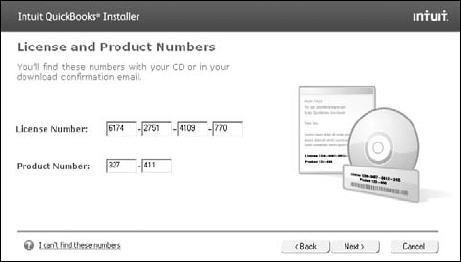If you haven't already installed QuickBooks, get it over with right now:
Turn on the PC.
Find and flip on the computer's power switch. (Depending on which version of Windows 2000, XP, Vista, or 7 you're using, your screen may look a little different from the figures here. I'm using Windows Vista, by the way. Not that you care, or that it matters. . . .)
Tip
If you're installing QuickBooks on a computer running a professional or business edition of Windows, you may need to log on as either the administrator or a user with administrator rights. With the business flavors of the Windows operating systems, Windows security features require an administrator to install the QuickBooks program.
Rip open the QuickBooks package and get out the CD (which looks exactly like the ones that play music).
Insert the CD into your CD-ROM drive.
Windows recognizes that you inserted the QuickBooks CD and displays a little message box that tells you "Welcome to QuickBooks." Click Next to really get things started.
Indicate that you accept the QuickBooks licensing agreement and then click Next.
QuickBooks next asks whether you agree to play by its rules, as outlined in tedious detail in the licensing agreement displayed onscreen. Assuming you do — and you have to agree in order to install the software — select the I Accept The Terms of the License Agreement (But Only Because I Have No Other Choice) button and click Next.
Select the Express installation option and click Next.
When the Choose Installation Type window appears (see Figure A-1), select the Express option and then click the Next button. The installation program begins, asking several awkward technical questions — how much you weigh, whether you watch your cholesterol, whether you always wear your seatbelt — but don't tie yourself in knots. Just accept the default, or suggested, answers. (The default installation options are fine for 999 of 1,000 users.)
You don't have to choose the Express installation option. You can, instead, choose the Custom installation option, which lets you specify stuff such as where the QuickBooks program and data files get stored. I don't talk about these options here because most people won't want to (and shouldn't) make these customizations. What's more, if you're someone who can safely customize the QuickBooks installation settings, you don't need my help with figuring out how this stuff works.
Provide the License and Product Number and then click Next.
Finally, the License and Product Numbers window appears (see Figure A-2). Enter these two bits of licensing information (they should be printed on a yellow sticker on the back of the CD sleeve) and then click Next.
Begin the installation.
The installation program tells you, at long last, that it is ready to begin as soon as you click Install. Click Install. The program slowly begins extracting files from the CD. Did I mention that this process is slow? Think glacier sliding down the side of a mountain.
While the installation program runs, you can see a little bar that shows your progress.
If you need to cancel the installation at any time, just click Cancel. QuickBooks warns you that the setup is incomplete. That's okay; just start the setup from scratch next time around.
Take 30 minutes or so to contemplate the meaning of life or get a drink of water.
When the Install program finishes, click Finish.
Congratulations. You're finished with the installation. You have a new item on the Programs menu and probably new shortcuts on your desktop.
(Optional) Celebrate.
Stand up at your desk, click your heels together three times, and repeat the phrase, "There's no place like home." And watch out for flying houses.
As soon as you're done celebrating, you may want to flip to Chapter 2 and find out how to register the program. You'll probably want to register QuickBooks before you begin using it.
Note
If you work on a network and want to share a QuickBooks file stored on one computer with another computer on the network, you need to install QuickBooks on all the other computers that you want to use to work with the file. Note: You need a separate copy of QuickBooks — such as from the five-pack version — for each computer on which you want to install QuickBooks.
By the way — and I mention this just because I had a couple of clients ask about this — running QuickBooks on a network with multiple QuickBooks users isn't super-tricky or terribly complicated. QuickBooks takes care of the hard stuff. If you have more than one person using QuickBooks, you owe it to yourself (and your business) to set up a network and then purchase and install multiple copies of QuickBooks. Read Appendix C for more information.


